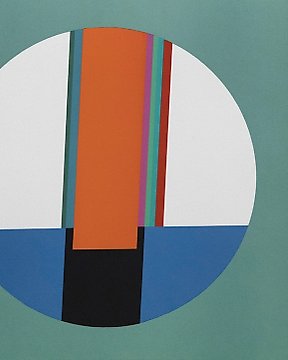
Eugenio Carmi (1920 - 2016) - Finestra immaginaria
N. 81996969

N. 81996969

Alain JACQUET (1939-2008)
Bille de Genève, 1972
Sérigraphie sur papier
Signée et numérotée de la main de l'artiste
Dimensions : 47 x 47 cm
Provenance : Éditions du Griffon, Neuchâtel
The mid-1960s corresponded to Jacquet’s period of creative effervescence. He moved to the Chelsea Hotel in New York for a few months, meeting Alexander Iolas who exhibited a retrospective of his “Camouflages” in his Manhattan gallery in 1964: a photo of Leo Castelli and Roy Lichtensteinposing with Alain Jacquet in a camouflaged suit, this memorable vernissage continues. He also meets Andy Warhol with whom he shares a taste for photomechanical reporting and screen printing. It is not trivial that Alain Jacquet, who settled more permanently in New York from 1965 to 1967, felt an affinity with American Pop art. Guy Scarpetta, in a study on the artist, reminds us that Pierre Restany had noted that his work is situated on the side of reproduction and not of the real object, of “representation”, and not of “presentation” 2. Nevertheless, Jacquet clearly distinguished himself from the artists of American Pop Art by refusing the direct and immediate character of their works to prefer a complex pictorial system, based on polysemy and the mutation of images.At the end of the 1960s, Jacquet, who began working with gallery owner Daniel Varenne, explored new artistic territories by creating very radical works, more in the nature of conceptual art (he was the only French to be exhibited by Harald Szeemann in his famous exhibition “When Attitude Becomes Form” at the Kunsthalle in Bern in 1969). Thus, he is interested in the expansion of the mesh of a burlap, he studies the screen printing transposition of floors (Plancher no 7, 1969), that of corrugated iron on a flat surface, he uses transparent Plexiglas plates to create different color sequences normally gathered by the principle of the frame (Landmark). It was also the time when Jacquet indulged in free interpretations of Marcel Duchamp, by producing “Ready-made” which are only the extension of his citational art and the affirmation of his desire to put an end to the idolatry of the original and fascination with the creative act (Arrosoir, 1972). Jacquet is interested in other transcription codes than frames and, initiating himself into esoteric thought, he studies systems like writing in Braille, digital transfers, the combinatorics of the hexagrams of the Yi-King (Mandala, 1972). Iconic work of this period, the sculpture-installation La Baratte, 1971-1975 which he will present at the Venice Biennale of 1976, consisting of sixty-four superimposed discs each carrying the sixty-four signs of Braille, has the particularity of presenting almost unlimited combinatorial possibilities.In the 1970s, Jacquet continued his work of decomposing the image of the frames from images of the Earth taken by the astronauts during the Apollo space mission and carried them out on canvas by concentric frame as shown by First Breakfast, 1972. The iconic image of the terrestrial globe will give rise to an infinite number of variations in the configuration and superposition of continents, oceans, and clouds, in the manner of camouflage.
Come fare acquisti su Catawiki
1. Scopri oggetti speciali
2. Fai l’offerta più alta
3. Paga in tutta sicurezza